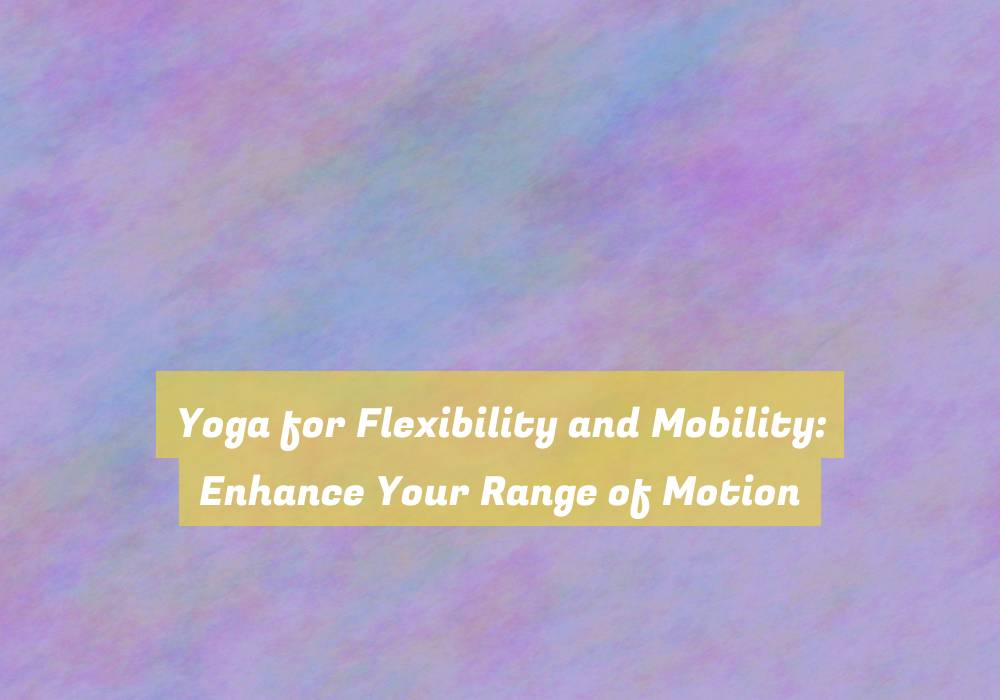Yoga for Flexibility and Mobility: Enhance Your Range of Motion
If youG??ve ever struggled to touch your toes or found it difficult to turn your head from side to side, youG??re not alone. This is where yoga can make a significant difference.
By incorporating yoga into your fitness routine, you can gradually improve your flexibility and mobility, leading to a wider range of motion and increased ease of movement.
But how exactly does yoga achieve this, and what specific poses and techniques are most effective? LetG??s explore the ways in which yoga can enhance your flexibility and mobility, and how you can begin to experience these benefits for yourself.
Benefits of Yoga for Flexibility
Regularly practicing yoga can significantly improve your flexibility, making it easier to move and perform everyday activities. The various yoga poses and stretches work to lengthen and stretch muscles, tendons, and ligaments, increasing your overall range of motion. This increased flexibility not only enhances your physical performance but also reduces the risk of injury during other activities. By regularly engaging in yoga, you can gradually improve your flexibility, allowing you to bend, twist, and reach with greater ease.
Additionally, yoga helps to release tension and tightness in the body, particularly in areas like the hips, hamstrings, and shoulders. This can be especially beneficial for individuals who spend a lot of time sitting or engaging in repetitive activities, as it counteracts the effects of prolonged immobility. Improved flexibility can also lead to better posture and alignment, as the muscles become more balanced and supple. As a result, you may experience reduced aches and pains, as well as an overall feeling of lightness and ease in your body.
Key Yoga Poses for Mobility
To enhance your mobility through yoga, incorporate key poses that target different muscle groups and movements.
Start with the Downward-Facing Dog, which stretches the hamstrings, calves, and shoulders while also strengthening the arms and legs. This pose also improves spinal flexibility and encourages overall body alignment.
Next, the Warrior II pose helps open up the hips and chest, promoting better mobility in these areas. It also strengthens the legs and core, supporting stability and balance.
The Cat-Cow pose is excellent for mobilizing the spine, increasing flexibility and relieving tension in the back. It also engages the core and promotes better posture.
Incorporating the Pigeon pose into your routine will stretch the hip flexors, groin, and glutes, enhancing hip mobility and flexibility.
Finally, the Seated Forward Bend targets the lower back, hamstrings, and calves, improving flexibility in the entire posterior chain.
These key yoga poses will help you enhance your mobility and range of motion, allowing you to move more freely and comfortably in your daily activities.
Breathing Techniques for Flexibility
Incorporating specific breathing techniques while practicing the key yoga poses for mobility can significantly enhance your overall flexibility and range of motion. Deep, diaphragmatic breathing is essential during yoga practice as it helps to release tension in the muscles and allows for a greater range of motion.
When you inhale deeply, your lungs expand, sending oxygen-rich blood to your muscles, which can help them relax and stretch further. As you exhale, you can sink deeper into the pose, allowing for increased flexibility.
Another effective technique is to synchronize your breath with your movements. For example, inhaling as you lengthen or extend your body, and exhaling as you fold or twist, can help you move more fluidly and with greater ease.
Additionally, using breath awareness can help you identify areas of tension in your body, allowing you to consciously relax those muscles and deepen the stretch.
Yoga Sequences for Enhanced Range of Motion
How can specific yoga sequences help enhance your range of motion and flexibility?
Yoga sequences designed to enhance range of motion focus on targeting various muscle groups and joints through a combination of dynamic and static stretches. These sequences often incorporate poses that specifically stretch and strengthen the muscles surrounding the hips, spine, shoulders, and hamstrings, which are crucial for improving flexibility and mobility.
For example, a sequence that includes poses like Downward-Facing Dog, Warrior II, Triangle Pose, and Pigeon Pose can help release tension in the hips and hamstrings while also opening up the chest and shoulders. Additionally, incorporating flowing sequences such as Sun Salutations can help improve overall flexibility and mobility by engaging multiple muscle groups and promoting fluid movement.
The repetition and synchronization of breath with movement in these sequences also contribute to increased flexibility and range of motion. By consistently practicing these targeted yoga sequences, you can gradually enhance your overall range of motion, improve flexibility, and experience increased ease and comfort in your body.
Conclusion
So, if you want to improve your flexibility and mobility, try incorporating yoga into your routine.
With its focus on gentle movements, deep stretching, and mindful breathing, yoga can help you increase your range of motion and feel more agile in your daily activities.
Whether youG??re a beginner or experienced yogi, there are poses and sequences that can help you achieve your flexibility and mobility goals.
Give it a try and see the difference it can make in your body!






